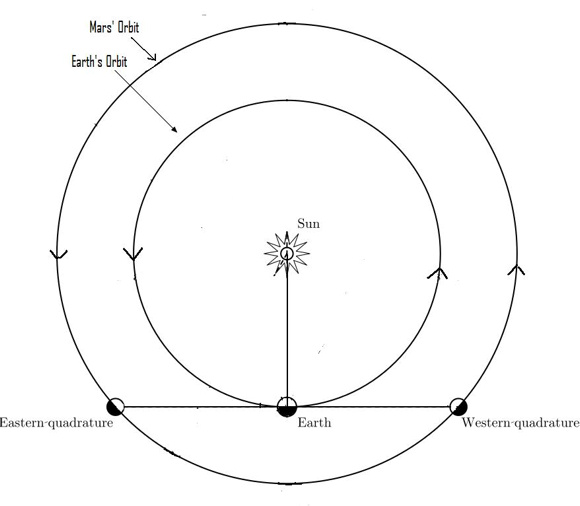As the Eta Aquariid meteor shower picks up steam these next several mornings – May 3, 4 and 5, 2021 – watch for the waning moon to sweep past the ringed planet Saturn and then the giant planet Jupiter. On May 3, the moon passes due south of Saturn, to stage a conjunction, only a few hours before the moon reaches its half-illuminated last quarter phase. A little over one day after the moon-Saturn conjunction, the moon will sweep due south of the king planet Jupiter. Meanwhile, as for Neptune, although we show you its location on our chart above, it is not visible to the eye.
Read more: All you need to know: Eta Aquariid meteors
Here’s some astronomy jargon for you. Technically speaking, the moon is said to be at dichotomy when it appears half-illuminated to us, yet at quadrature when the moon is 90 degrees from the sun on the sky’s dome. The two events (dichotomy and quadrature) almost happen concurrently, at least as far as the moon is concerned, at the first or last quarter phase. A half-illuminated last quarter moon is synonymous with west quadrature, that is, with the moon being 90 degrees west of the sun. In common usage, many think of dichotomy and quadrature as synonymous. Yet did you know that a quarter moon is always a tiny bit more than 50% illuminated? It is around 50.13% illuminated at the last quarter phase, such a small amount more than 50% that the difference isn’t visually discernible.
The moon reaches its last quarter phase (west quadrature, or 90 degrees west of the sun) on May 3. Not to be outdone, Saturn reaches west quadrature on this date as well. Thus we see the moon near Saturn in the sky. At quadrature, the sun-Earth-Saturn angle equals 90 degrees, with Earth residing at the vertex of this angle. Unlike the moon, Saturn does not appear even close to half-illuminated at quadrature. That’s because Saturn is a superior planet (orbiting outside of Earth’s orbit), and all superior planets always appear full or nearly full, never half-illuminated, as seen from Earth.
For some telescope enthusiasts, Saturn at quadrature (90 degrees west of the sun) is a celebrated event. That’s because Saturn’s shadow appears maximally sideways from Saturn at quadrature, providing the best view of Saturn’s shadow crossing its glorious rings.
Jupiter will reach west quadrature this month, too, on May 21. For some telescope aficionados, Jupiter at quadrature counts as a big thrill because, as with Saturn, that’s when Jupiter’s shadow points most sideways of Jupiter. This is the best time to watch Jupiter’s moons – Io, Europa, Ganymede and Callisto – being eclipsed in Jupiter’s shadow. Learn more about Jupiter’s moons via SkyandTelescope.org.
Read more: Jupiter’s equinox and mutual events of its 4 major moons

The moon is exactly half-illuminated at dichotomy, yet a tiny bit more than half-illuminated at quadrature (quarter moon). The moon always reaches dichotomy (50% illumination) a short while before its first quarter phase; and the moon always reaches its last quarter phase shortly before dichotomy. Depending on the month, the time period between dichotomy and quadrature can vary anywhere from about 15 to 21 minutes.
When the moon is at quadrature (quarter phase) in Earth’s sky, then it’s the Earth that’s at dichotomy in the moon’s sky. The converse is also true: When the Earth is at quadrature (quarter phase) in the moon’s sky, then it’s the moon that’s at dichotomy in Earth’s sky.
Unlike superior planets, the inferior planets – planets orbiting the sun inside of Earth’s orbit – display dichotomy at certain points in their orbits. Yet, the inferior planets (Mercury and Venus) never reach quadrature in Earth’s sky, as superior planets do. Inferior planets never go as far as 90 degrees from the sun. At most, Mercury swings 28 degrees from the sun in Earth’s sky and Venus 47 degrees.
Want more? See this cool diagram of dichotomy vs. quadrature via GeoGebra!

Bottom line: Watch for the waning moon to swing to the south of the ringed planet Saturn and then south of the king planet Jupiter around May 3, 4 and 5, 2021. The moon and Saturn both reach west quadrature on May 3, whereas Jupiter’s west quadrature will come on May 21, 2021.











